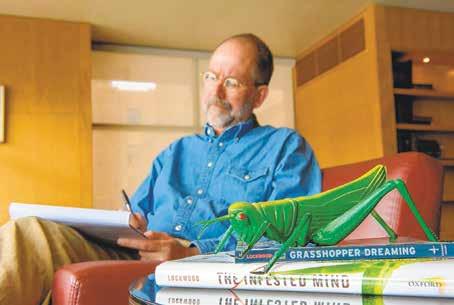
4 minute read
NATURE & ART Catoctin Mountain Park Artist in Residence Jeffrey Lockwood
Art has been part of the history of national parks since the 1860s when Hudson River School painters captured the majestic Western landscapes that became our first iconic national parks. Their awe-inspiring works spurred Americans to preserve those lands for future generations.
Artist George Catlin, during an 1832 trip to the Dakotas, was perhaps the first to suggest the idea of a national park. Catlin traveled extensively and noted that Indian civilization, wildlife and the wilderness were in danger unless they could be preserved “by some great protecting policy of government … in a magnificent park … a Nation’s Park, containing man and beast, in all the wild[ness] and freshness of their nature’s beauty!”
Today, there are Artist in Residence programs in more than 50 National Park Service units which preserve the connection between arts and the parks. Catoctin Forest Alliance manages the local Artist in Residence program jointly with Catoctin Mountain Park NPS and Cunningham Falls State Park MPS. Selections for the program are made by a panel that includes art experts from local colleges. In addition to accepting a variety of visual media, the program in 2013 began accepting written media as well.
Jeffrey Lockwood from Laramie, Wyoming, will be the Catoctin Forest Alliance Artist in Residence at Catoctin Mountain Park May 8 to 27.
Some 40 years ago, Lockwood earned a bachelor of science degree in biology and a Ph.D. in entomology. The choice of the latter field was motivated by a fascination with the life forms that were disturbingly and enchantingly “other.”
He was hired as an insect ecologist at the University of Wyoming in 1986, and for 15 years, he immersed himself in the lives of insects. His work focused on grasshoppers and locusts, taking him to the steppes of Asia and the Tibetan plateau, the savannah of Africa, the outback of Australia — and back to the grasslands of North America.
With time, however, he found him - self no longer fulfilled by applied research which had become a euphemism for the wholesale killing of grasshoppers, creatures that had grown close to his heart and mind.
This led to his first book of essays, “Grasshopper Dreaming: Reflections on Killing and Loving” (Skinner House 2002). Over the next five years, he transitioned (or perhaps metamorphosed) from the College of Agriculture & Natural Resources into the College of Arts & Sciences, where he settled into a split appointment between the Department of Visual & Literary Arts (focusing on creative nonfiction in the realm of nature and environmental writing) and the Department of Philosophy & Religious Studies (focusing on environmental ethics and aesthetics).
Lockwood will be presenting two free public writing workshops.
• Children’s writing workshop: Spring Rains and Cinquains — 1 to 2 p.m. May 13 at the Thurmont Regional Library, 76 E. Moser Road, Thurmont.
Kids love poetry (even if grownups tend to take the fun out of creative writing by imposing silly rules about rhyming and whatnot).
And kids love the outdoors (even if grownups tend to take the fun out of poking around in ant hills and dung piles). So what could be better than combining these two, fundamentally fun ventures?
You’ve probably heard about short forms of poetry, such as haiku and limerick, but in this workshop participants will play with an unusual form called the cinquain. The “rules” for a cinquain are few and invite writers to explore the natural world using short, evocative lines that capture their sense of joy and wonder.
In fact, see if you can figure out what makes this poem a cinquain (hint: count the syllables):
“November Night” by Adelaide Crapsey
Listen…
With faint dry sound, Like steps of passing ghosts, The leaves, frost-crisp’d, break from the trees
And fall.
• Adult writing workshop: Minute Memoirs — 7 to 8 p.m. May 17 at the Thurmont Regional Library
Writing the story of your life is a common goal for many people but one that is rarely achieved. This workshop will absolutely assure success in this regard. Of course, a 200page memoir is a bit daunting, so we’ll start smaller. Much smaller. Like 10 words. Really.
This will be a creative and playful workshop in which you’ll compose no fewer than three memoirs (keeping in mind a memoir is not an autobiography but reveals a particular aspect of one’s life). All that you need to bring is a sense of puckish possibility and some moving memories. And if you’re dubious of such a venture, then consider some of these evocative 6-word memoirs:
Extremely responsible, secretly longed for spontaneity.
I still make coffee for two.
Veni, vidi, but haven’t vici yet. Must remember: people, gadgets. That order.
CFA was established in 2009 as a partner organization to Catoctin Mountain Park NPS and Cunningham Falls State Park MPS. One of the CFA founders was artist Elizabeth Prongas, who began the local AIR program in 2010 to bring a new and diverse voice and constituency to the parks.
Since the inception of the AIR program, CFA has welcomed 31 artists to the Catoctin Mountains. They have come from California, Kentucky, Tennessee, Massachusetts, Maryland, New Jersey, New York, Oregon and Virginia. The artists include painters, photographers, poets, a writer, a videographer, cast metal artist, a wool felter, a journaling artist and this year, a fabric artist/quilter.
The artists stay in a historic cabin in Catoctin Mountain Park for one to three weeks and produce art influenced by the mountain setting. After the residency, each artist donates one piece of the art they created during their stay to the CFA AIR collection.
The AIR art collection has been on exhibit at the Delaplaine Arts Center in Frederick, the Thurmont Library, the Emmitsburg Library and the Visitor Center in the Manor Area of Cunningham Falls State Park. The collection permanently housed in Catoctin Mountain Park.









